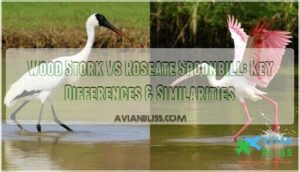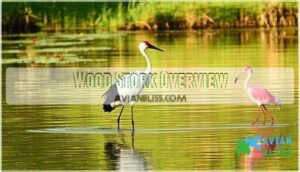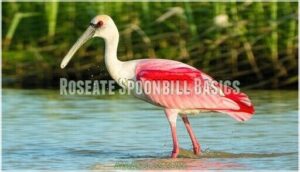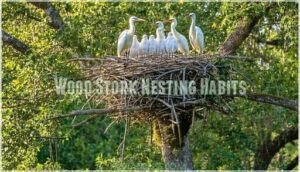This site is supported by our readers. We may earn a commission, at no cost to you, if you purchase through links.

Wood storks are larger, measuring 40 inches with 61-inch wingspans and weighing 5.3 pounds, while roseate spoonbills reach 32 inches with 50-inch wingspans at 3.3 pounds.
Their beaks tell different stories – wood storks sport long, thick bills perfect for tactile feeding, whereas spoonbills use their distinctive spatula-shaped beaks to strain small prey from water.
Wood storks wear mostly white plumage with dark flight feathers, while spoonbills flaunt vibrant pink and red coloration that intensifies during breeding season.
Both species share similar wetland habitats but employ completely different hunting strategies.
Table Of Contents
- Key Takeaways
- Wood Stork Overview
- Roseate Spoonbill Basics
- Wood Stork Vs Roseate
- Conservation Status
- Unique Characteristics
- Frequently Asked Questions (FAQs)
- How do you identify a wood stork?
- What is the roseate spoonbills closest relative?
- What is another name for a wood stork?
- Is it rare to see a roseate spoonbill?
- What is another name for a Wood Stork?
- What is the nickname for the roseate spoonbill?
- What is the difference between a Wood Stork and an ibis?
- What is the difference between a white pelican and a Wood Stork?
- How do their lifespans compare in the wild?
- Which species is more adaptable to climate change?
- Conclusion
Key Takeaways
- Size difference is dramatic – You’ll spot wood storks towering at 40 inches with 61-inch wingspans, while roseate spoonbills reach only 32 inches with 50-inch wingspans, making identification easier from a distance.
- Their feeding methods couldn’t be more different – Wood storks use tactile "groping" with sensitive bill tips to feel for prey, while roseate spoonbills sweep their spoon-shaped beaks through water to filter small creatures.
- Coloration tells the species story – You’ll see wood storks in white plumage with black flight feathers, contrasting sharply with roseate spoonbills’ vibrant pink coloring that intensifies during breeding season.
- Both face conservation challenges but show different adaptability – Wood storks recovered from endangered to threatened status through habitat protection, while roseate spoonbills struggle more with climate change impacts and are already shifting their range northward.
Wood Stork Overview
When you spot a large wading bird standing motionless in shallow water, you might be looking at a Wood Stork, one of North America’s most distinctive wetland species.
These impressive birds stand nearly four feet tall and showcase a unique combination of white plumage, dark flight feathers, and a distinctive bare, dark head that sets them apart from other wading birds in their habitat.
Physical Characteristics
Three massive differences separate the wood stork from most wading birds.
Standing 33-45 inches tall with a 55-71 inch wingspan, this impressive bird identification challenge becomes easier when you spot these key features:
- Size Differences: Wood storks tower above other wading birds at over 3 feet
- Beak Morphology: Heavy, downward-curved bill perfectly designed for tactile feeding
- Plumage Details: White body contrasts sharply with black wing tips and tail
- Juvenile Appearance: Young birds show brownish feathers before developing adult coloration
Habitat and Range
You’ll find wood storks across the southeastern United States, with Florida serving as their primary stronghold.
These impressive birds call mixed hardwood swamps, cypress domes, and mangrove forests home, preferring forested wetlands with standing water for nesting.
| Region | Primary Habitats | Water Preference |
|---|---|---|
| Florida | Cypress swamps, mangroves | Fresh to brackish |
| Georgia/Carolinas | Hardwood swamps, sloughs | Freshwater dominant |
| Gulf Coast | Coastal marshes, lagoons | Brackish to saltwater |
| Central America | Tropical wetlands | Variable salinity |
| South America | River deltas, floodplains | Freshwater systems |
Their range extends from North Carolina down through Mexico and Central America, reaching northern Argentina.
Unlike many wading birds, wood storks show remarkable flexibility in their habitat choices, adapting to freshwater swamps, brackish marshes, and even estuarine environments.
They’re categorized as Least Concern by the IUCN.
This adaptability has helped them maintain populations across diverse coastal wetlands and inland water systems throughout their extensive regional distribution.
Feeding Behavior
Wood storks demonstrate remarkable feeding behaviors.
You’ll find these coastal birds using tactile foraging techniques, feeling for fish with their bills submerged in shallow water.
Their prey selection includes fish, frogs, and invertebrates.
Unlike similar birds that rely on visual hunting, wood storks depend on touch, requiring specific water depths for hunting success.
This specialization affects juvenile feeding patterns.
Breeding and Nesting
During breeding season, wood storks gather in impressive colonies that can house hundreds of pairs.
These coastal birds construct sturdy nests using sticks and vegetation, typically in cypress trees or mangroves.
Colony size directly influences chick development success rates.
Nesting seasonality coincides with dry periods when fish concentrate in shallow waters.
Both parents provide dedicated parental care, taking turns feeding and protecting their young through extensive foraging trips.
They’re tactile foragers, relying on sensitive bills to locate prey.
Roseate Spoonbill Basics
You’ll recognize a roseate spoonbill instantly by its vibrant pink plumage and distinctive spoon-shaped bill that sets it apart from other wading birds.
These striking birds inhabit coastal wetlands across the southeastern United States, where they use their specialized beaks to sweep through shallow waters in search of small fish, crustaceans, and aquatic invertebrates, which is a key part of their coastal lifestyle.
Distinctive Features
Since you immediately recognize this roseate spoonbill bird species through stunning plumage details, you’ll spot unmistakable field marks that separate it from other waders.
- Beak morphology: Distinctive spatula-shaped bill perfect for tactile foraging
- Leg coloration: Bright pink to reddish-pink legs matching overall body tones
- Flight patterns: Extended neck posture during flight differentiates from herons
This remarkable bird comparison reveals bright pink feathers and a giant spoon-shaped bill alongside light pink wings with darker pink fringe, creating vocalizations through bill-clattering displays.
They’re often found in coastal southeastern U.S..
Migration Patterns
You’ll notice the roseate spoonbill follows different Migration Routes than many bird species.
These birds migrate from southeastern U.S. Breeding Grounds to Caribbean and northern South American Wintering Habitats.
Migration Triggers include late summer wetland drying and reduced food availability.
Most Florida populations stay year-round, while others travel 600-1,200km.
Climate Impact increasingly affects their traditional patterns, with habitat loss forcing more frequent movements between areas.
They thrive in shallow water habitats across the globe.
Diet and Foraging
You’ll spot these birds using unique foraging techniques in florida’s wetlands.
Roseate spoonbills sweep their distinctive spoon-shaped bills through shallow waters to catch crustaceans, small fish, and aquatic insects.
Their prey selection shows remarkable feeding efficiency compared to other gulf coast birds.
Their distinctive feeding behavior is key to their survival.
These feeding habits showcase impressive adaptations:
- Prey includes mollusks, frogs, newts, and minnows ignored by larger waders
- Tactile foraging allows hunting in murky waters
- Diet overlap with egrets creates habitat impact through competition
- Groups coordinate sweeping motions for maximum efficiency
- Birdwatching tips: observe morning feeding behavior for best viewing
Social Behavior
You’ll discover roseate spoonbills are surprisingly social birds that engage in flocking dynamics throughout most seasons.
These elegant waders communicate through soft grunting calls and visual displays, establishing social hierarchy within their groups.
While they don’t practice cooperative hunting like some species, their territory defense and communication methods reveal complex bird behavior patterns that distinguish them from solitary feeders, showcasing their unique approach to flocking dynamics.
Wood Stork Vs Roseate
You’ll notice significant differences when comparing these two distinctive wading birds side by side.
The wood stork’s imposing size and unique feeding technique contrasts sharply with the roseate spoonbill’s vibrant plumage and specialized spoon-shaped bill.
The comparison highlights the distinctive characteristics of each bird.
Size and Weight Comparison
When comparing these wading birds, you’ll notice stark Average Dimensions and Body Mass differences that reveal their ecological niches.
Wood storks tower over roseate spoonbills, creating distinct bird physical features for bird species comparison.
| Feature | Wood Stork | Roseate Spoonbill |
|---|---|---|
| Body Length | 85-115cm | 71-86cm |
| Weight | 2.5-4.5kg | 1.2-1.8kg |
| Wingspan Differences | 140-180cm | 120-133cm |
| Leg Length | 60-65cm tall | 50-60cm tall |
These bird differences reflect specialized adaptations, while Growth Rates show storks reaching adult size slower than spoonbills despite their larger frame.
Plumage and Coloration
You’ll instantly recognize these birds by their striking color differences. While wood storks sport mostly white plumage with contrasting black flight feathers, roseate spoonbills display vibrant pink feather pigmentation that develops through their diet.
| Feature | Wood Stork | Roseate Spoonbill |
|---|---|---|
| Primary Color | White with black accents | Pink with deeper rose tones |
| Display Plumage | Minimal seasonal variation | Intensifies during breeding |
| Camouflage Function | Blends with white sand/clouds | Matches pink coral environments |
Color development in spoonbills occurs through carotenoid consumption, creating plumage variation from pale pink to deep rose. Wood storks maintain consistent coloration year-round, while spoonbills’ display plumage intensifies seasonally.
Their tactile foraging method allows them to efficiently capture prey in murky waters. These physical characteristics serve different purposes – the stork’s neutral tones provide effective camouflage in wetland environments, whereas the spoonbill’s vivid colors signal reproductive fitness and species recognition during courtship displays.
Beak Shape and Function
When examining these florida birds, you’ll notice their beaks tell different stories about bird anatomy and feeding strategies.
Stork Beak Morphology features a long, sturdy design for Tactile Foraging, while Spoonbill Bill Function centers on its distinctive spoon-shaped tip packed with Beak Sensory Receptors that enhance Feeding Efficiency through specialized bird characteristics.
| Feature | Wood Stork | Roseate Spoonbill |
|---|---|---|
| Shape | Long, thick, slightly curved | Flat, spoon-shaped tip |
| Length | 8-9 inches | 6-7 inches |
| Primary Function | Snap reflex feeding | Sweeping filter feeding |
| Sensory Ability | Touch-sensitive tip | Highly sensitive spoon |
| bird morphology Adaptation** | Probing muddy bottoms | Sifting shallow waters |
Habitat Preferences
You’ll find these birds prefer different wetland ecosystems for their daily needs.
Wood Stork habitat centers around freshwater marshes and swamps, while Spoonbill habitat favors coastal regions with saltwater access.
| Aspect | Wood Stork | Roseate Spoonbill |
|---|---|---|
| Primary Habitat | Freshwater swamps, marshes | Coastal mangroves, salt marshes |
| Nesting Locations | Cypress trees, tall rookeries | Low shrubs, colonial sites |
| Habitat Range | Inland wetlands, Florida birds | Coastal waters, tidal flats |
Their bird ecology reflects specialized adaptations – storks wade through shallow freshwater hunting fish, while spoonbills sweep their bills through brackish coastal waters filtering small prey.
Conservation Status
You’ll find that both wood storks and roseate spoonbills face significant conservation challenges, though their current status differs considerably.
While wood storks have made remarkable recovery progress after being listed as endangered, roseate spoonbills continue to deal with habitat loss and human interference that threatens their long-term survival.
Wood Stork Threats
Wood storks face severe conservation challenges that threaten their survival.
Habitat Loss from wetland drainage eliminates over 80% of historic nesting sites, while altered Water Quality and Prey Availability from development reduce food sources.
Climate Change brings unpredictable weather patterns, and Human Disturbance near colonies increases nest abandonment rates substantially.
Roseate Spoonbill Threats
Roseate Spoonbills face mounting challenges that threaten their survival across coastal regions.
These striking birds battle multiple environmental pressures simultaneously, creating a perfect storm of conservation concerns.
Key threats include:
- Habitat Loss from wetland conversion and coastal development reducing nesting sites
- Pollution Impacts through mercury bioaccumulation and agricultural runoff degrading water quality
- Climate Change effects causing sea-level rise and severe weather destroying colonies
- Food Scarcity from overfishing and altered water flow patterns reducing prey availability
Human activities continue driving these bird population declines, making bird species protection increasingly urgent for maintaining healthy ecosystems.
Protected Areas and Sanctuaries
You’ll discover numerous protected areas across North America where both wood storks and roseate spoonbills find refuge.
National Wildlife Refuges like Everglades and Merritt Island provide critical bird habitat through sanctuary management and habitat preservation programs.
These areas support species recovery while generating conservation funding through ecotourism impact, demonstrating how bird protection and bird conservation work together for effective bird species protection.
Consider exploring a wood stork sanctuary for related merchandise.
Conservation Efforts
When successful habitat restoration meets rigorous population monitoring, you’ll witness real progress in bird conservation.
Federal agencies collaborate on adaptive water management while community-based wetland projects boost nesting success.
The Wood Stork’s conservation status improved from endangered to threatened in 2014, proving effective policy enforcement works.
Public awareness campaigns highlight climate impacts, ensuring bird habitat preservation continues through targeted conservation efforts.
Unique Characteristics
You’ll notice fascinating differences when you compare these two wading birds’ most distinctive behaviors and adaptations.
Wood storks use a unique "groping" feeding technique with their specialized bills, while roseate spoonbills perform elaborate courtship displays that include bill clattering and dramatic plume presentations, which can be considered an elaborate form of "courtship" displays.
Wood Stork Nesting Habits
Beyond conservation challenges, understanding breeding behaviors reveals fascinating insights.
Wood storks demonstrate remarkable nest site selection strategies, choosing sturdy trees near water sources for ideal feeding access. Their colony size dynamics fluctuate based on environmental conditions and food availability.
A typical nest measures 20-25 inches wide.
Key wood stork nesting characteristics include:
- Nest building materials – They construct platforms using sticks, moss, and leaves
- Parental care duration extends 10-12 weeks from hatching to fledging
- Nesting success factors depend heavily on water levels and fish concentrations
- Bird breeding occurs during dry seasons when prey becomes concentrated in shallow pools
Roseate Spoonbill Mating Rituals
You’ll witness spectacular courtship displays during breeding season when these pink beauties perform elaborate dances and showcase their vibrant plumage.
Their pair bonding rituals involve synchronized movements and mutual preening that strengthen relationships before nest building begins.
| Behavior | Purpose | Timing |
|---|---|---|
| Courtship Displays | Attract mates | Early spring |
| Nest Building | Prepare for eggs | March-April |
| Chick Rearing | Raise offspring | 6-8 weeks |
These ritual significance moments create lasting bonds essential for successful bird breeding cycles, making them fascinating subjects for any birding guide studying bird behavior and bird taxonomy patterns.
Adaptations to Environment
You’ll encounter remarkable Foraging Adaptations in both species that showcase Climate Resilience.
Wood storks display Habitat Specificity through specialized tactile feeding in cypress swamps, while roseate spoonbills demonstrate Predator Avoidance by forming Symbiotic Relationships with other wading birds.
Their bird diet preferences reflect distinct bird classification differences, with unique bird physiology supporting bird biodiversity within wetland bird ecosystem communities.
Interesting Behaviors
You’ll discover wood storks perform unique thermoregulation by spreading their wings and defecating on their legs to cool down.
Roseate spoonbills showcase remarkable Social Interactions through synchronized feeding and elaborate Communication Methods using bill clattering.
Both species exhibit sophisticated Foraging Strategies and Predator Avoidance techniques while demonstrating exceptional Parental Care behaviors during nesting seasons.
Frequently Asked Questions (FAQs)
How do you identify a wood stork?
You’ll recognize wood storks by their massive size, distinctive bald black head and neck, long dark bill, and white body with black wing edges visible in flight.
What is the roseate spoonbills closest relative?
Like a feathered spoon stirring nature’s soup, you’ll find the roseate spoonbill‘s closest relative is the sacred ibis, both belonging to the threskiornithidae family of wading birds with specialized beaks.
What is another name for a wood stork?
You’ll find the alternative names for wood storks: "wood ibis" and "flinthead." Wood ibis refers to their ibis-like curved bill, while flinthead describes their scaly, featherless head.
Is it rare to see a roseate spoonbill?
You’ll find roseate spoonbills locally common in coastal Florida, Texas, and southwest Louisiana, but they’re expanding their range northward.
Outside these core areas, they’re quite rare and create excitement among birders when spotted, especially because they are locally common in certain regions.
What is another name for a Wood Stork?
You’ll call Wood Storks by their folk names like "Wood Ibis" or "flinthead" – terms earned from their ibis-like curved bills and scaly, featherless heads that resemble rough stone surfaces.
What is the nickname for the roseate spoonbill?
Pretty as a flamingo’s cousin, you’ll discover the roseate spoonbill’s endearing nickname is "teaspoons" when they’re babies.
Adults don’t have a widely-used nickname, though birdwatchers sometimes lovingly refer to them as "spoonies" in casual conversation.
What is the difference between a Wood Stork and an ibis?
You’ll spot key differences between Wood Storks and ibises in their bills and size.
Wood Storks have thick, curved bills and stand taller at 40 inches, while ibises sport thinner, more curved bills and measure around 25 inches tall.
What is the difference between a white pelican and a Wood Stork?
You’ll notice white pelicans are massive waterbirds with orange pouches and black wingtips, while Wood Storks are smaller, gray-bodied waders with dark, bald heads and long bills for probing mud.
How do their lifespans compare in the wild?
Let me spill the tea on these feathered drama queens’ lifespans. You’ll find wood storks live 11 years, 8 months in the wild, while roseate spoonbills average up to 10 years naturally.
Which species is more adaptable to climate change?
You’ll adapt better to climate shifts than roseate spoonbills.
Roseate spoonbills are already relocating northward due to climate pressures , while wood storks show greater exploratory range and territorial flexibility, suggesting superior adaptability.
Conclusion
Like two artists painting with different brushes, the wood stork vs roseate spoonbill comparison reveals nature’s creative diversity in wading bird design.
You’ve discovered how size, coloration, and feeding strategies distinguish these remarkable species.
Wood storks dominate with their impressive wingspan and tactile hunting methods, while roseate spoonbills captivate with vibrant plumage and unique filter-feeding techniques.
Both face conservation challenges requiring continued protection efforts.
Understanding these differences enhances your appreciation for wetland ecosystems and the specialized adaptations that allow multiple species to thrive in shared habitats.












